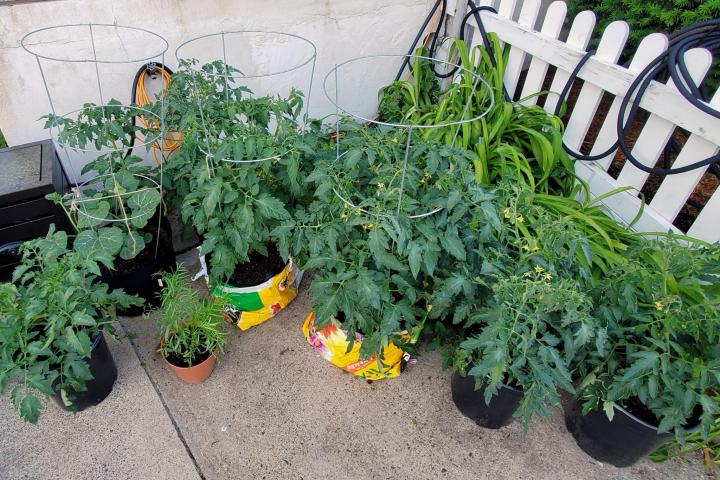For flower and vegetable containers that look great all summer long, a continuous supply of nutrients is an absolute must. Here are tips for feeding plants in pots, including a simple 3-step process that ensures your pots are getting what they need.
The Importance of Nutrients for Container Plants
My containers filled with petunias, salvia, lettuces, and tomatoes looked awful, especially when compared to those I planted in the ground later. I was accidentally starving the container plants because I didn’t replace nutrients that were leached out of the potting mix every time I watered. Unlike plants in the ground, which have roots to seek out additional nutrients, container plants are effectively quarantined from the nutrients, fungi, and bacteria naturally found in soil.
If you’re going to grow plants in containers, you’ll also need to lend a helping hand. Even if you’re using high-quality potting soil or compost, plants exhaust the available nutrients in containers within about six weeks.
Sure, you can sprinkle in some fertilizer pellets, as you might do with vegetables grown in the ground. But even that won’t be enough for some container plants, especially tomatoes and other big feeders! A regular liquid feed is best. You can buy liquid fertilizers or make your own. Diluted with water, they provide a shot of extra nutrients that ensure plants continue to grow well and be productive.

My 3-Step Container Fertilizer Program
Now, I use this three-step fertilizer program, and my container gardens flourish. Be sure to fertilize…
1. …when you are filling your containers with potting mix.
When you are starting your containers, incorporate fertilizer pellets into your potting mix. (If the potting mix contains fertilizer, skip this step.) You want “slow-release” fertilizer pellets that are coated with a polymer that lets them dissolve at varied rates; the thicker the coating, the longer it takes for the fertilizer in pellets to be released into the potting mix. Most brands feed plants for at least 60 days, but some supply a steady stream of nutrients for up to 120 days. Check the label on any product you buy for this information.

Slow-release food is also available in organic form. Fish meal pellets are formulated similarly to synthetic fertilizers. Cotton seed meal, feather meal, and alfalfa pellets are other slow-release, organic choices. All feed plants for about 60 days. The alfalfa also contains a hormone, triacontanol, which promotes plant growth.
2. …as your plants grow.
Apply a water-soluble (liquid) fertilizer to supplement the slow-release fertilizer. Water-soluble ones deliver nutrients directly to plant roots and are easy to apply. Dissolve them in water and pour the liquid into the container for a nutritional boost. Follow package directions for dilution rates and the amount of fertilizer to use on each container.
If you are buying liquid fertilizer, there are many types on the market. You want an equal ratio of “N-P-K” (nitrogen, phosphorus, potassium), which are the three nutrients that all plants need. A fertilizer with an equal amount of each nutrient is commonly called a “balanced” fertilizer, which you’ll see reflected in the label (e.g., 10-10-10). However, fruiting crops such as tomatoes and peppers need a liquid fertilizer with more phosphorus (P). For leafy plants such as lettuce and spinach, it’s fine to have more nitrogen to produce foliage, but any other plant would produce leaves at the expense of fruit.
Organic choices such as fish meal emulsion and liquid kelp work very well, too. In fact, some plants, like ferns and lettuce, respond better to organic products than synthetic fertilizers.
I like to use a liquid feed made from seaweed. I water all my vegetables with a dilute seaweed feed about once a month. Fruiting vegetables will need a tomato feed weekly (alternating with the seaweed feed once a month). Fertilize throughout the growing season from spring until late summer.
Note: There are some container plants that really do not need to be fed as they grow. Cut-and-come-again lettuces or other salad leaves don’t typically need a regular feed, as they are usually harvested before they use up their supply. Herbs shouldn’t need to be fed at all, particularly lavender, thyme, or rosemary; they do best in nutrient-poor, drier conditions.

3. …if plants appear stressed or need a pick-me-up.
If plants need a quick pick-me-up due to stressors (such as extreme temperatures or drought) or heavy production of flowers or fruit, apply fertilizer directly to plants’ leaves. Deadhead old blooms, cut back damaged foliage, and then spray water-soluble fertilizer on leaf tops and undersides. The foliar spray delivers nutrients directly to where photosynthesis takes place. Results are dramatic—you’ll see growth or renewal almost overnight.
If plants are looking a bit under the weather, I water with my diluted seaweed solution or even spray the seaweed solution directly onto the leaves and that will often sort them out.

Use any spray bottle or garden sprayer and follow the dilution rates given on the fertilizer package.
A word of caution about foliar feeding: Don’t do it when temperatures are above 90ºF or when the sun is beating on plants directly. The fertilizer could burn leaves. The best time to foliar feed is in the morning or early evening.
Make Your Own Liquid Fertilizer
Liquid fertilizer can get pricy, depending on the size of your container garden, so consider making your own by steeping “weeds” or other nutrient-packed plants in water.
Comfrey is commonly used in homemade liquid fertilizer. It’s great for fruiting vegetables because it contains a good dose of potassium. Nettles or borage can be used in the same way for a higher-nitrogen alternative, which is beneficial for leafy vegetables.
→ See our post on how to make organic fertilizer from comfrey or other herbs and weeds.
Compost Tea
You could also make a “Compost Tea,” which is a good overall plant health booster (a little like vitamins for people) and helps plants be better able to resist pests and diseases. See how to make compost tea.













